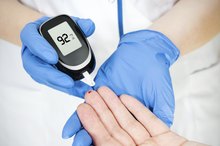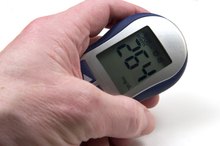What Are the Blood Sugar Levels for Diabetes?
Blood sugar levels for diabetics are slightly different from blood sugar levels for people without diabetes. Because a diabetic's blood sugar can vary more than an average person's can, there is a larger range for the diabetic. Doctors consider this range safe for the diabetic; though, all diabetics should strive to keep glucose or blood sugar levels as stable as possible to prevent sugar highs and sugar lows. Keeping stable blood sugar levels requires monitoring blood sugar and watching the intake of carbohydrates.
Measurement
Blood sugar is measured in milligrams per deciliter and percentage of sugar in the blood. The average milligrams per deciliter for non-diabetics are 70 to 100 mg/dL. After fasting for 14 hours, the measurement is percent. The average is four to five percent. The range for a diabetic is 70 to 120 mg/dL or a percentage of seven or under, after fasting for 14 hours.
- Blood sugar is measured in milligrams per deciliter and percentage of sugar in the blood.
- The range for a diabetic is 70 to 120 mg/dL or a percentage of seven or under, after fasting for 14 hours.
After Eating
Diabetes & Hot Flashes After Eating Breakfast
Learn More
Everyone's blood sugar rises after eating. Even a person who is not diabetic may have blood sugar levels as high as 175 mg/dL after a meal. The difference for a non-diabetic is the sugar levels drop to normal faster than the sugar rates of a diabetic. However, a diabetic should try to keep blood sugar levels under 180 mg/dL after a meal. The diabetic measures the blood glucose two hours after starting to eat. Higher levels indicate that the diabetic consumed too many carbohydrates or fatty foods.
- Everyone's blood sugar rises after eating.
- However, a diabetic should try to keep blood sugar levels under 180 mg/dL after a meal.
Highs
Dangerous highs are 240 mg/dL that do not return to normal. When sugar levels are high, the body breaks down fat for fuel. Ketones are the byproduct that is normally removed from your body through your urine. When sugar rises and the ketones are present, the kidneys cannot keep up. Ketones appear in the blood causing the blood to become acidic. The body increases the urine output causing dehydration. Symptoms include vomiting, blurry vision, weakness, confusion and a fruity odor on the breath.
- Dangerous highs are 240 mg/dL that do not return to normal.
- Ketones appear in the blood causing the blood to become acidic.
Lows
About Dangerous Levels of Blood Sugar
Learn More
Lows are sugar levels below 70 mg/dL. A diabetic may not feel symptoms with lows under 70 mg/dL until the lows reach 50 mg/dL for a male and 40 mg/dL for a female. Blood sugar lows are caused by too much insulin, not enough food, exercise, alcohol and stress. Symptoms include:
- shakiness
- dizziness
- confusion
- sweatiness
- hunger
- blurred vision
- a tingling around the mouth
- Lows are sugar levels below 70 mg/dL.
- A diabetic may not feel symptoms with lows under 70 mg/dL until the lows reach 50 mg/dL for a male and 40 mg/dL for a female.
- Blood sugar lows are caused by too much insulin, not enough food, exercise, alcohol and stress.
Pre-diabetes
Pre-diabetes is glucose levels that are higher than normal but not high enough to be considered diabetic. A fasting test is down to determine pre-diabetes. After fasting for 14 hours, the lab technician draws your blood. If the fasting levels are 100 to 125 mg/dL, you are considered pre-diabetic.
- Pre-diabetes is glucose levels that are higher than normal but not high enough to be considered diabetic.
- If the fasting levels are 100 to 125 mg/dL, you are considered pre-diabetic.
Related Articles
References
- Schönfeld P, Reiser G. Why does brain metabolism not favor burning of fatty acids to provide energy? Reflections on disadvantages of the use of free fatty acids as fuel for brain. J Cereb Blood Flow Metab. 2013;33(10):1493–1499. doi:10.1038/jcbfm.2013.128
- American Diabetes Association. Diabetic Ketoacidosis.
- American College of Emergency Physicians. Diabetic Emergencies.
- American Diabetes Association. Hyperglycemia (High Blood Glucose).
- American Diabetes Association. Hypoglycemia (Low Blood Glucose).
Writer Bio
Pauline Gill is a retired teacher with more than 25 years of experience teaching English to high school students. She holds a bachelor's degree in language arts and a Master of Education degree. Gill is also an award-winning fiction author.









